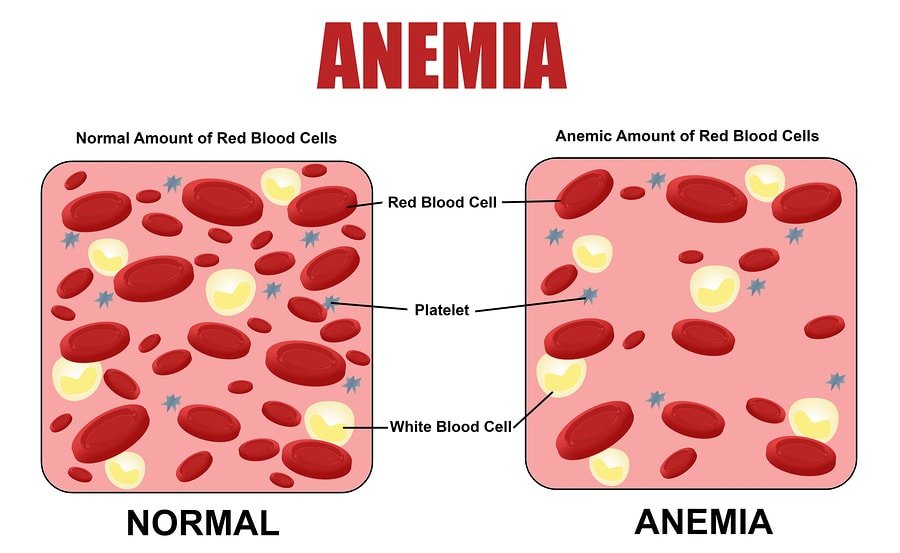Iron deficiency anaemia is the most prevalent anaemia worldwide. According to the World Health Organization, approximately 1,620 million people worldwide suffer from anaemia, of which 1,000 million suffer.
Iron deficiency anaemia occurs when the body has less iron than it needs. This is necessary, among other functions, so that red blood cells can be formed, which are essential to carry oxygen from the lungs to the body’s different tissues. Specifically, haemoglobin is the part of the red blood cell that carries oxygen. Therefore, in patients with iron deficiency anaemia, haemoglobin levels will be decreased.
Why does this type of anaemia occur?
The leading causes of this anaemia are:
- High blood loss. For example, due to frequent or prolonged menstruation in the case of women or due to other haemorrhages such as those due to some pathologies such as inflammatory bowel disease.
- Low intake of iron or problems in the absorption of this mineral.
- Increased iron requirements, as is the case during growth spurts in children, adolescents, and pregnancy.
- There are two kinds of iron in food: heme iron and non-heme iron. The former is found only in foods of animal origin and the latter in animal and plant-origin foods.
- Heme iron is absorbed to a greater extent than non-heme iron, and the various components of food (except for calcium, which decreases its absorption) do not appear to modify its absorption.
- In the case of non-heme iron, many dietary components influence its absorption. Thus, some increase it. For example, vitamin C is present in fruits such as kiwi, orange and strawberry, or animal proteins.
- Instead, there are other components of the diet that decrease its absorption. For example, phytic acid and phytates decrease their absorption in legumes and whole grains, polyphenols in tea, coffee and red wine, or calcium in dairy products.
How to avoid iron deficiency anaemia?
- Do not carry out very low-calorie diets unless necessary since they usually provide little iron.
- Intake of foods rich in iron must be increased, without forgetting that iron of animal origin is better absorbed than that of plant origin. In the case of iron of animal origin, we can find it in high amounts in red meat, black pudding, liver, mussels and cockle.
- When taking iron from plant sources, combine your intake with dietary components that increase absorption. For example, legumes, rich in iron, with a kiwi rich in vitamin C, increase their absorption.
- Separate the intake of foods rich in iron of vegetable origin for at least two hours from foods that contain compounds that decrease their absorption, such as tea, coffee and milk.
It is worth mentioning that diet can help prevent iron deficiency anaemia. Still, if it is already established, it should always be accompanied by pharmacological treatment, which usually consists of administering iron orally.
Top iron-rich foods
This mineral is essential at all stages of life and should be consumed frequently, but it must be increased during pregnancy and old age when there is a greater need for iron in the body. Good examples of iron-rich foods are red meat, black beans, and barley bread.
There are two types of iron, heme iron: present in red meat and non-heme iron, present in vegetables. The iron in meat is better absorbed, while the iron in vegetables needs a source of vitamin C for better absorption.
The iron in foods of animal sources presents absorption of iron at the intestinal level between 20 to 30% of the total ingested mineral. In contrast, the iron in foods of vegetable origin allows absorption of around 5% of the total iron in their composition. For this reason, it is essential to eat them with foods rich in vitamin C, such as oranges, pineapples, strawberries and peppers, as they favour the absorption of this mineral at the intestinal level.
Daily iron requirements
The daily need for iron, as shown in the table, varies according to age and gender, as women have a greater need for iron than men, especially during pregnancy.
Daily iron requirements increase in pregnancy because the body’s blood increases; therefore, iron is needed to produce more blood cells, just as iron is needed for the baby’s development and the placenta. Meeting iron requirements during pregnancy is significant, but iron supplementation may be necessary, which should always be advised by a doctor.
Age group daily Iron Need
Babies: 7-12 months 11 m g
Children: 1-3 years 7 mg
Children: 4-8 years 10 mg
Boys and Girls: 9-13 years 8 mg
Boys: 14-18 years old 11 mg
Girls: 14-18 years old 15 mg
Men: >19 years 8 mg
Women: 19-50 years old 18 mg
Women: > 50 years 8 mg
pregnant 27 mg
Nursing mothers: < 18 years 10 mg
Nursing mothers: > 19 years 9 mg

